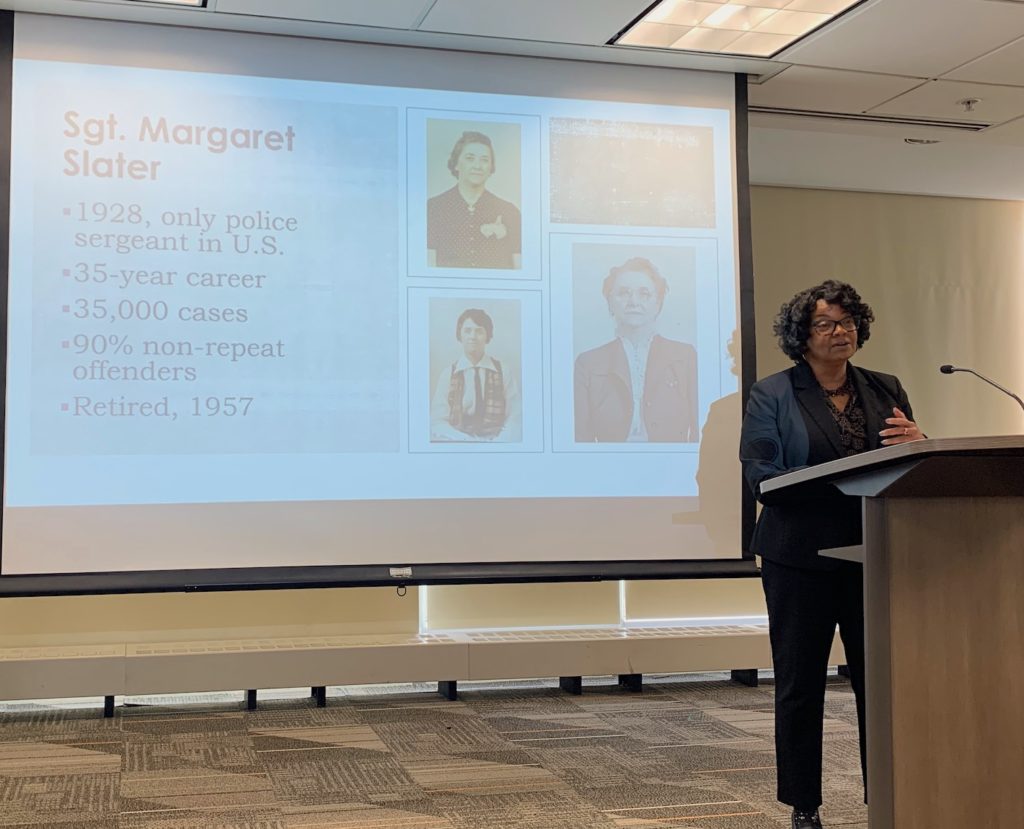By JULIE CARLE
BG Independent News
Shirley Green traded her police lieutenant cap for a doctoral tam after she retired from the Toledo Police Department after 27 years.
With three history degrees in hand, she has found a niche as an adjunct history professor at Bowling Green State University and University of Toledo, and as director of the Toledo Police Museum.
Green talked about “The History of Women in Law Enforcement” for the BGSU History Department’s recent Women’s History Month Lecture.
While she described law enforcement in general, such as how law enforcement was established in the north as a means of maintaining social control for a “stable and orderly workforce” compared to the south’s desire to create a slave patrol, her main focus was how and when women fit into the history of law enforcement in the nation and Toledo.
The first women in law enforcement were jail matrons who were hired to oversee the women and juveniles in jail. The earliest matrons started in 1845, and Toledo first jail matron was hired by Toledo City Council in 1888. Often jail matrons were married to or widows of police officers, Green said.
Other cities had hired women to be police officers as early as 1891; Mary Shaw was hired in November 1920s as Toledo’s first policewoman. She was paid by the Toledo Boxing Commission until city council passed an ordinance to create the position and salary of a policewoman. She was assigned to investigate Toledo’s dance halls “to stop naughty behaviors like cheek-to-cheek dancing,” Green said.
Eventually, Shaw thought the dance hall assignment was a waste of personnel and recommended that the dance hall managers be responsible for the activities in their own halls.

Margaret Slater was another important advocate and mentor for women in Toledo’s department. She was hired in 1922 and after she was told “you won’t last a week,” she was promoted to sergeant in 1928 and lasted for 29 years before retiring. She handled more than 35,000 cases throughout her career and recorded an impressive 90% non-repeat offenders, Green said.
Women were being hired in small numbers within police departments in the early part of the 20th century, but they were not entrusted with weapons for quite some time, she stated. And there was rampant discrimination in the kinds of work they were assigned to. Almost exclusively they were in the Women’s Bureau, dealing only with women and juveniles.
In 1946, women, for the first time, went through training with the men. From 1946 through 1972, they took the Civil Service Exam. After 1972’s passage of Title VII, which outlawed gender discrimination in public agencies,
Though the advertisement for the 1972 Toledo Civil Service Test was targeted to “able, ambitious, young men” there were 199 men and four women who took the tests that year. A total of 95 men and one woman were hired.
The battle over the name policewomen v. patrolman was finally tipped when Carol Tipton was the first woman to graduate from the Toledo Police Academy with the rank of Patrolman.
Green was among the first class in 1976 that deemed women were ready for street duty, but there was a discrepancy in uniforms between men and women. The men had straight clip-on ties and the women wore cross-bow ties. “The ties led to the first of many grievances. Not only did they make the women look different from the men, there was a safety concern,” Green said.
“Other actions were filed as well because hiring women didn’t get rid of the disparities,” she said.
Green worked on a good shift where her colleagues were open-minded to her position on the department. However, the public was not as quick to accept women as officers.
She heard, “You don’t belong here” or “You took some man’s job away from him,” yet she was the only Black female to date to make Lieutenant.
The number of women in policing has improved since the early days, but there are new efforts to “reframe the profession to appeal to more women,” Green said.
The FBI has recently announced its 30 x 30 Pledge aimed to engage 30% of women in police recruit classes by 2030 and to ensure policing agencies are truly representative of the jurisdictions they serve, including demographic diversity.



